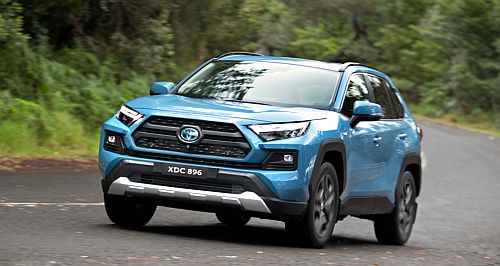News - VFACTS - Sales 2024VFACTS: New record set in 2024Despite economic and political challenges, new car sales record achieved in 20246 Jan 2025 By MATT BROGAN AUSTRALIANS purchased more new cars than ever before in 2024, setting a record of 1,220,607 registrations for the outgoing calendar year – or 0.3 per cent up on 2023 – according to VFACTS data compiled by the Federal Chamber of Automotive Industries (FCAI).
Despite the impressive number, industry analysts warn of tougher times ahead, as economic and political challenges were attributed to a slowing of new car purchases in the second half of last year.
This was borne out in the December result, the monthly figure down 2.7 per cent year-on-year to 95,895 units, despite an identical number of selling days (24).
FCAI chief executive Tony Weber said that while very strong sales in the first half of 2024 set up the full-year result, the momentum in the market was lost as the year progressed.
“The second half of the year showed a concerning trend with sales in the private segment falling to very low levels as interest rates and general cost of living pressures impacted Australian families,” he said.
“Customers are also increasingly making choices regarding environmental outcomes and the associated total cost of ownership of moving to low emissions technologies.
“So, while the sales of battery electric vehicles are lower than expected, this is offset to a degree by an increasing number of buyers turning to hybrid and plug-in hybrid models which make up 14.1 per cent and 1.9 per cent of the total market respectively.”
Diesel vehicle sales tallied 369,842 (-2.5 per cent YoY) for the 2024 calendar year, while petrol vehicle sales totalled 528,978 (-10.1 per cent).
Hybrid vehicle sales rose to 172,696 (+76.0 per cent), while VFACTS recorded battery electric vehicle (BEV) sales as finishing the year with 74,612 units (-14.5 per cent), and plug-in hybrids 23,163 (+100.2 per cent).
The BEV figures exclude Tesla and Polestar results for the second half of the year as they ceased reporting sales to VFACTS from July 1 following a dispute over New Vehicle Efficiency Standard (NVES) lobbying. The Electric Vehicle Council (EVC), which has been tracking both brands since then, said the 2024 total included “approximately 91,000 BEVs”.
“It means nearly one in ten new car sales were EVs (9.65 per cent). This compares to a market share of 8.45 per cent in 2023,” reported the EVC.
This would have put the 2024 overall sales total up to 1,236,995 units, or 1.7 per cent up on 2023 instead of the officially recorded 0.3 per cent increase.
Mr Weber said the Australian automotive industry was “responding to NVES by increasing the range of zero and low emission vehicles on offer” and went on to claim that "a continuation of current customer buying preferences will inevitably lead to the accrual of substantial penalties under the government’s new scheme, which will create price inflation within the new vehicle market”.
Mr Weber said lower than expected sales results for battery electric vehicles were being replicated in several major markets around the world.
“Governments around the world have set regulations that are ahead of available zero emissions technologies and this is impacting both car makers and consumers,” he continued.
“Manufacturers in the UK, Europe and the USA are under pressure because they have made huge investments to manufacture EVs, but customers are not buying them in the numbers needed to meet emission targets and to provide a return on investment.
“In Australia, ideally, we will continue to see governments invest in EV recharging infrastructure across the country. The Commonwealth government should apply revenue raised through NVES penalties to recharging infrastructure.
In addition, I urge the Commonwealth government to support its emissions reduction policies by considering ongoing consumer support such as a continuation of the FBT exemption for plug-in hybrid vehicles which is due to end on 1 April 2025.
“If consumers do not want, cannot afford or cannot find new low emission vehicles that meet their needs, then no amount of effort from governments and car makers will make a difference.”
Looking at buyer preferences more closely, VFACTS figures show the passenger vehicle market is down by 2240 units (-13.8 per cent) over the same month last year, the SUV market up by 5602 units (+10.7 per cent), the light commercial vehicle market down 5811 units (-22.7 per cent), and the heavy commercial vehicle market down 200 units (-4.6 per cent) versus December 2023.
“While overall consumer preferences remain clear with SUVs and light commercial vehicles continuing to dominate the market and especially the top ten sales, many vehicles in these segments are either difficult or expensive to decarbonise,” added Mr Weber.
“This will prove to be a significant challenge in meeting the extremely ambitious targets of the New Vehicle Efficiency Standard (NVES) which began on 1 January 2025.”
Across the marques, Toyota was again the leader in December (and across 2024), followed by Ford and Mazda. Toyota notched up 18,657 unit sales for the month, leading Ford by a margin of 10,352 unit sales and 10.8 market share points.
Ford sold 8305 units for the month of December, followed by Mazda with 7256, Kia with 6302, and Mitsubishi with 5754.
The Toyota RAV4 was again Australia’s best-selling vehicle in December with sales of 5119 units. It was followed by the Ford Ranger with 4493 unit sales, the Toyota HiLux with 3333, Toyota LandCruiser Prado with 2687, and the Ford Everest with 2476.
For the calendar year 2024, Toyota was the biggest selling brand with sales of 241,296 and 19.8 per cent market share followed by Ford (100,170 and 8.2 per cent), Mazda (95,987 and 7.9 per cent), Kia (81,787 and 6.7 per cent), and Mitsubishi (74,587 and 6.1 per cent).
Across the states, sales in the Australian Capital Territory down 8.9 per cent in December to 1221 when viewed against the same period last year. New South Wales was down 1.7 per cent to 28,200, the Northern Territory down 10.6 per cent to 664, Queensland decreased 4.4 per cent to 20,259, South Australia also decreased by 13.5 per cent to 6175, Tasmania had a decrease of 11.5 per cent to 1862, Victoria decreased 2.7 per cent to 26,755, and Western Australia increased 9.2 per cent to 10,759.
Top 10 vehicle sales by make (2024):
Top 10 vehicle sales by model (December 2024):
State by state (December 2024):
*All data supplied courtesy of the FCAI.  Read more4th of December 2024  VFACTS: Demand slows in NovemberTough times impact new cars sales, Australian market declines 11.6pc in November6th of November 2024  VFACTS: A million sales and countingDespite easing growth, Australian new car sales have passed the million mark in October |
Click to shareVFACTS articlesResearch VFACTS Motor industry news |
















Facebook Twitter Instagram